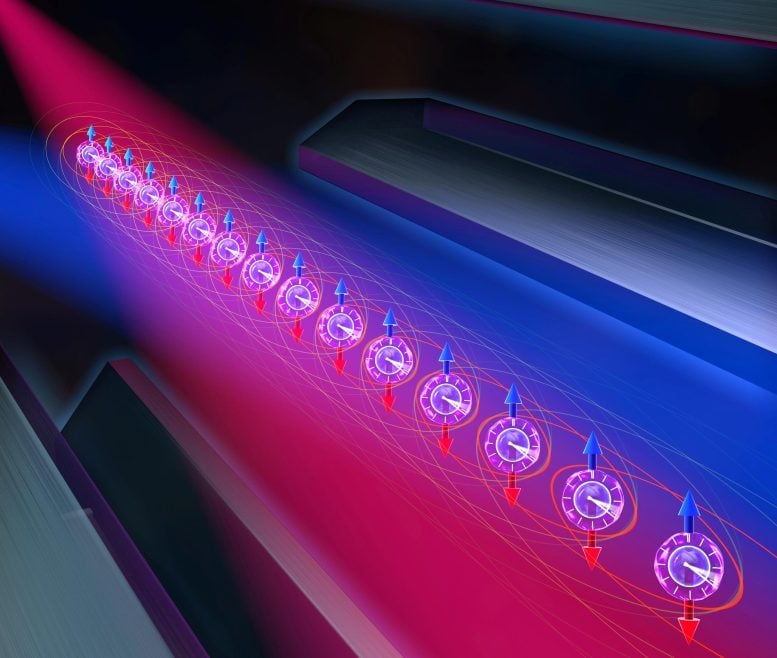
Higher accuracy atomic clocks, such as the “tweezer clock” depicted here, could result from linking or “entangling” atoms in a new way through a method known as “spin squeezing,” in which one property of an atom is measured more precisely than is usually allowed in quantum mechanics by decreasing the precision in which a complementary property is measured. Credit: Steven Burrows and the Rey Group/JILA
Researchers have developed methods to entangle large numbers of particles, improving the precision and speed of quantum measurements. These advancements could revolutionize quantum sensors and atomic clocks, with potential applications in fundamental physics research.
Opening new possibilities for quantum sensors, atomic clocks, and tests of fundamental physics, JILA researchers have developed new ways of “entangling” or interlinking the properties of large numbers of particles. In the process they have devised ways to measure large groups of atoms more accurately even in disruptive, noisy environments.
The new techniques are described in a pair of papers published in Nature.[1] JILA is a joint institute of the National Institute of Standards and Technology (NIST) and the University of Colorado Boulder.
The Magic of Entanglement
“Entanglement is the holy grail of measurement science,” said Ana Maria Rey, a theoretical physicist and a JILA and NIST Fellow. “Atoms are the best sensors ever. They’re universal. The problem is that they’re quantum objects, so they’re intrinsically noisy. When you measure them, sometimes they’re in one energy state, sometimes they’re in another state. When you entangle them, you can manage to cancel the noise.”
When atoms are entangled, what happens to one atom affects all the atoms entangled to it. Having dozens — better yet, hundreds — of entangled atoms working together reduces the noise, and the signal from the measurement becomes clearer, more certain. Entangled atoms also reduce the number of times scientists need to run their measurements, getting results in less time.
One means of entanglement is with a process called spin squeezing. Like all objects that obey the rules of quantum physics, atoms can exist in multiple energy states at once, an ability known as superposition. Spin squeezing reduces all those possible superposition states in an atom to just a few possibilities. It’s like squeezing a balloon. When you squeeze the balloon, the middle shrinks and the opposite ends become bigger. When atoms are spin squeezed, the range of possible states they can be in narrows in some directions and expands in others.
Overcoming Distance in Atomic Interaction
But it’s harder to entangle atoms that are farther away from each other. Atoms have stronger interactions with atoms that are closest to them; the farther away the atoms, the weaker their interactions.
Think of it like people talking at a crowded party. People closest to each other can have a conversation, but those across the room can barely hear them, and the information gets lost down the line. Scientists want the whole party of atoms to talk to each other at the same time. Physicists around the world are all looking at different ways to achieve that entanglement.
“A major goal in the community is to produce entangled states to get higher-precision measurements in a shorter amount of time,” said Adam Kaufman, a physicist and JILA Fellow.
Kaufman and Rey worked together on proposals to achieve that entanglement, one of which Rey and her collaborators at the University of Innsbruck in Austria demonstrated.
Pushing Boundaries With Ion Experiments
In this experiment, the team lined up 51 calcium ions in a trap and used lasers to induce interactions between them. This is because the laser excites phonons, vibrations sort of like sound waves between the atoms. Those phonons spread down the line of atoms, linking them together. In prior experiments, these links were engineered to be static, so an ion could only talk to a specific set of ions when illuminated by the lasers.
By adding external magnetic fields, it was possible to make the links dynamic, growing and changing over time. That meant an ion that could talk to only one group of ions at first could talk to a different group, and eventually, it was able to talk to all other ions in the array. This overcomes that distance problem, Rey says, and the interactions were strong all the way down the line of atoms. Now all the atoms were working together, and they could all talk to each other without losing the message along the way.
Within a short amount of time, the ions became entangled, forming a spin-squeezed state, but with a little more time, they transformed into what’s called a cat state. This state is named for Erwin Schrodinger’s famous thought experiment about superposition, in which he proposed that a cat trapped in a box is both alive and dead until the box is opened and its state can be observed. For atoms, a cat state is a special kind of superposition in which the atoms are in two diametrically opposed states, like up and down, at the same time. Cat states are highly entangled, Rey points out, making them especially great for measurement science.
Future Directions and Optical Clocks Enhancement
The next step will be to try this technique with a two-dimensional array of atoms, upping the number of atoms to improve how long they can stay in these entangled states. Additionally, it could potentially let scientists make measurements more precisely and much quicker.
Spin-squeezing entanglement could also benefit optical atomic clocks, which are an important measurement science tool. Kaufman and his group at JILA, along with collaborators in NIST/JILA colleague Jun Ye’s group, tested a different method in another study in this issue of Nature.[2]
The researchers loaded 140 strontium atoms into an optical lattice, a single plane of light to hold the atoms. They used finely controlled beams of light, called optical tweezers, to place the atoms into little subgroups of 16 to 70 atoms each. With a high-power ultraviolet laser, they excited the atoms into a superposition of their usual “clock” state and a higher-energy Rydberg state. This technique is called Rydberg dressing.
The clock state atoms are like the quiet people at the crowded party; they don’t strongly interact with others. But for atoms in the Rydberg state, the outermost electron is so far from the center of the atom that the atom is effectively very large in size, enabling it to interact more strongly with the other atoms.
Now the whole party is talking. With this spin-squeezing technique, they can create entanglement across the entire array of 70 atoms.
The researchers compared frequency measurements between 70-atom groups and found that this entanglement improved precision below the limit for unentangled particles, known as the standard quantum limit.
Quicker, more precise measurements will allow these clocks to be better sensors to search for dark matter and produce better time and frequency measurements.
For more on this research, see Entanglement Enhanced Sensing Paves Way for Advanced Quantum Sensors.
References:
- “Quantum-enhanced sensing on optical transitions through finite-range interactions” by Johannes Franke, Sean R. Muleady, Raphael Kaubruegger, Florian Kranzl, Rainer Blatt, Ana Maria Rey, Manoj K. Joshi and Christian F. Roos, 30 August 2023, Nature.
DOI: 10.1038/s41586-023-06472-z - “Realizing spin squeezing with Rydberg interactions in an optical clock” by William J. Eckner, Nelson Darkwah Oppong, Alec Cao, Aaron W. Young, William R. Milner, John M. Robinson, Jun Ye and Adam M. Kaufman, 30 August 2023, Nature.
DOI: 10.1038/s41586-023-06360-6



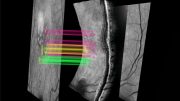
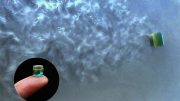
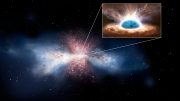

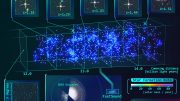
Very good! Congratulations to you all.
Spin creates everything, spin creates the world, spin creates the future.
According to topological vortex gravitational field theory, vortices (matter) and antivortices (antimatter) are formed simultaneously, with the same geometric shape but opposite directions of rotation. Countless topological vortices make spacetime motion more complex via the synchronous effects of superposition, deflection, and twisting. Therefore, there is so much data coming in from the LHC, the most powerful accelerator in the world, that recording it all has never been an option.
All observable movements in the physical world are inseparable from the interaction of topological vortices, including human observational behavior itself.
The universe does not do algebra, formula or fraction. The universe is geometrythe, and is the superposition, deflection, and twisting of geometric shapes.
Today, we have already entered the era of the internet. With the help of artificial intelligence and big data, discussions on scientific knowledge have become open and transparent. However, a group of editors of so-called academic journals (such as Physical Review Letters, Nature, Science, etc.) are self righteous, self proclaimed, fooling the public, lack remorse, and mystifying themselves. They only care about their own so-called sufficiently high priority rating, general significance, discipline, novelty, etc., and do not care about what science and pseudoscience are.
Science and pseudoscience are not determined by a publication, an organization or a person, nor by you or me, but by mathematics the final say. Physical models must be based on mathematics or mathematical models in order to be scientific, convincing, and in accordance with natural laws.
The origin of geometry lies in the concerns of everyday life. The branch of geometry (mathematics) known as topology has become a cornerstone of modern physics. Topological vortex and antivortex are two bidirectional coupled continuous chaotic systems. They exhibit parity conservation, charge conjugation, and time reversal symmetry. The synchronization effect is extremely important in their interactions. The synchronization effect of the superposition, deflection, and twisting of multiple or countless topological vortices will make spacetime motion more complex. To understand this complex world, physics should respect the authenticity of topological vortex in low dimensional spacetime, rather than simply relying on a few formulas, numbers, or imagined particles.
Spin is a natural property of topological vortices. Spin is synchronized with energy, spin is synchronized with gravitation, spin is synchronized with time, spin is synchronized with evolution. The perpetually swirling topological vortices defy traditional physics’ expectations. One physical properties of topological vortices is them to spontaneously begin to change periodically in time, even though the system does not experience corresponding periodic interference. Therefore, in the interaction of topological vortices, time is both absolute and relative,and physics often requires treating space and time at the same level.
Low-dimensional spacetime matter is the foundation of high-dimensional spacetime matter. Low-dimensional spacetime matter (such as topological vortex) can form new material structures and derive more complex physical properties via interactions and self-organization. It is extremely wrong and irresponsible to imagine low dimensional spacetime matter using high-dimensional spacetime matter,such as a cat in quantum mechanics.
Science must follow mathematical rules. For example, the Standard Model (SM) is considered to be one of the most significant achievements of physics in the 20th century. However, the magnetic moment of μ particle is larger than expected, revealed by a g-2 experiment at Fermilab, suggests that the established theory (such as SM) of fundamental particles is incomplete. Furthermore, the SM omitting gravitation, it not involved the time problem and when the particle movement starts. Mathematics is the foundation of science. Physics must respect the scientific nature of mathematics and mathematical models. The SM must be based on mathematical models in order to be scientific, convincing, and in line with natural laws.
I hope researchers are not fooled by the pseudoscientific theories of the Physical Review Letters (PRL), and hope more people dare to stand up and fight against rampant pseudoscience.
The so-called academic journals (such as Physical Review Letters, Nature, Science, etc.) firmly believe that two high-dimensional spacetime objects (such as two sets of cobalt-60) rotating in opposite directions can be transformed into two objects that mirror each other, is a typical case of pseudoscience rampant.
If researchers are really interested in Science and Physics, you can browse https://zhuanlan.zhihu.com/p/643404671 and https://zhuanlan.zhihu.com/p/595280873.
The Physical Review Letters (PRL) is the most evil, ugly, and dirty publication in the history of science. Nature and Science have been influenced by Physical Review Letters (PRL) and are even more notorious. The behavior of these pseudo-academic publications has seriously hindered the progress and development of human society in science and technology.
I am well aware that my relentless repetition can make some people unhappy, but in the fight against rampant pseudoscience, that’s all I can do.
Very good! Congratulations to you all.
According to topological vortex gravitational field theory, spin creates everything, spin creates the world, spin creates the future.